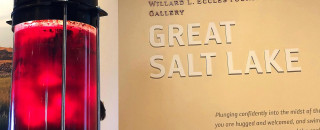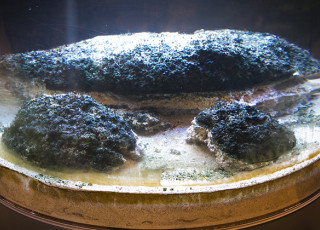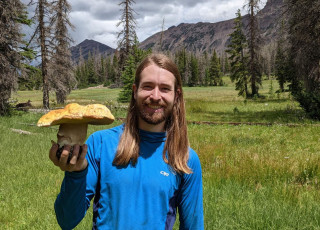A Recipe For Extreme Organisms
Halophiles in the Great Salt Lake Gallery. Photo © NHMU
By Riley Black
Look at the Great Salt Lake and you might think of the vast body of water as lifeless. That’s far from the truth, of course. Not only is the Great Salt Lake home to an incredible number of brine shrimp—fodder for migrating birds looking to refuel—it also boasts microscopic life that’s adapted to the harsh conditions of the super-salty water. They’re called halophiles, and the Natural History Museum of Utah exhibit staff came up with a perfect recipe to help them thrive in an exhibit about the local lake.
There’s no single biological category for halophiles. “Most of them are bacteria,” Museum exhibit services supervisor Will Black said, “but they could also be eukaryotes,” or organisms made up of a cell or cells containing their DNA inside a nucleus. Regardless of their classification, though, Black notes that what makes halophiles distinct is right there in their name: halophile is Greek for “salt-loving.”
The Great Salt Lake is a great place for salt-loving life. “The north arm of the Great Salt Lake is commonly at saturation levels, about 27 percent salt,” Black said, and extreme halophiles are typically found wherever salt in the water reaches over 20 percent. So, with that in mind, Black and the exhibits team set about trying to culture halophiles for the museum’s exhibit.
Getting life to grow in such salty conditions is rough. Using a device called a Winogradsky column, which helps culture bacteria and other microorganisms, Black and colleagues tried to get organisms to grow in high salt conditions like those found naturally in the lake. Barely anything other than green algae grew in the column for the first four tries, but, on the fifth try, halophiles finally thrived, given off by their red color.
The process took months. “I collected water and sediment from the north arm of the lake on October 20, 2017,” Black said, mixing the natural materials with nutrients in the Winogradsky column back at the museum. The special recipe included plenty of base materials for the halophiles to draw from, including sawdust, chalk, dry milk, rice, gypsum, epsom salt, fertilizer, and even Parmesan cheese, among other ingredients. Heated and lit to simulate the proper conditions, and the halophiles began to take hold.
“It’s amazing how red it is,” Black said, which mimics the look of the Great Salt Lake. “The north arm of the lake can be very pink or red at times of the year, and this color comes from the extreme halophiles.” What thrives in the exhibit’s column is a close-up look at the inner life of the famous lake.
Riley Black is the author of My Beloved Brontosaurus, Prehistoric Predators, and a science writer for the Natural History Museum of Utah, a part of the University of Utah in Salt Lake City. Our mission is to illuminate the natural world and the place of humans within it. In addition to housing outstanding exhibits for the public, NHMU is a research museum. Learn more.



